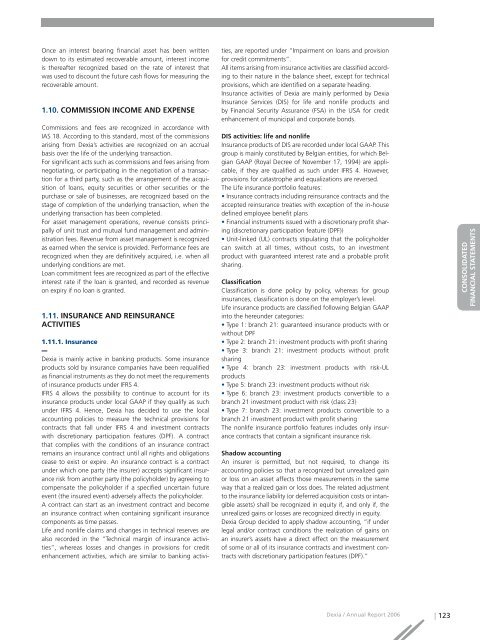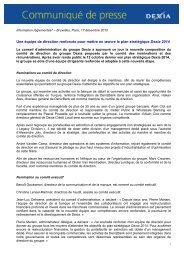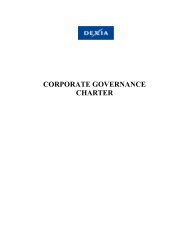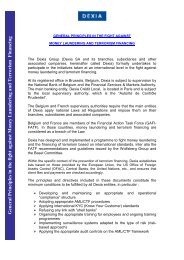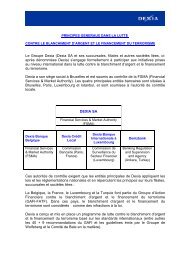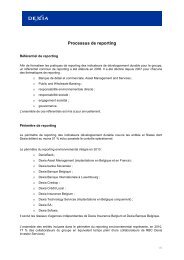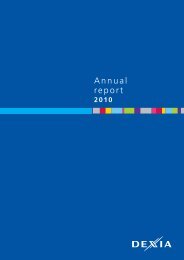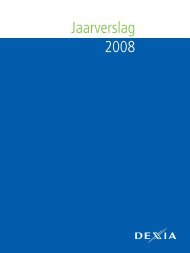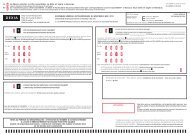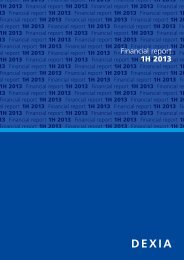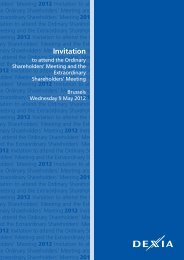Annual report 2006 - Dexia.com
Annual report 2006 - Dexia.com
Annual report 2006 - Dexia.com
Create successful ePaper yourself
Turn your PDF publications into a flip-book with our unique Google optimized e-Paper software.
Once an interest bearing financial asset has been written<br />
down to its estimated recoverable amount, interest in<strong>com</strong>e<br />
is thereafter recognized based on the rate of interest that<br />
was used to discount the future cash flows for measuring the<br />
recoverable amount.<br />
1.10. COMMISSION INCOME AND EXPENSE<br />
Commissions and fees are recognized in accordance with<br />
IAS 18. According to this standard, most of the <strong>com</strong>missions<br />
arising from <strong>Dexia</strong>’s activities are recognized on an accrual<br />
basis over the life of the underlying transaction.<br />
For significant acts such as <strong>com</strong>missions and fees arising from<br />
negotiating, or participating in the negotiation of a transaction<br />
for a third party, such as the arrangement of the acquisition<br />
of loans, equity securities or other securities or the<br />
purchase or sale of businesses, are recognized based on the<br />
stage of <strong>com</strong>pletion of the underlying transaction, when the<br />
underlying transaction has been <strong>com</strong>pleted.<br />
For asset management operations, revenue consists principally<br />
of unit trust and mutual fund management and administration<br />
fees. Revenue from asset management is recognized<br />
as earned when the service is provided. Performance fees are<br />
recognized when they are definitively acquired, i.e. when all<br />
underlying conditions are met.<br />
Loan <strong>com</strong>mitment fees are recognized as part of the effective<br />
interest rate if the loan is granted, and recorded as revenue<br />
on expiry if no loan is granted.<br />
1.11. INSURANCE AND REINSURANCE<br />
ACTIVITIES<br />
1.11.1. Insurance<br />
<strong>Dexia</strong> is mainly active in banking products. Some insurance<br />
products sold by insurance <strong>com</strong>panies have been requalified<br />
as financial instruments as they do not meet the requirements<br />
of insurance products under IFRS 4.<br />
IFRS 4 allows the possibility to continue to account for its<br />
insurance products under local GAAP if they qualify as such<br />
under IFRS 4. Hence, <strong>Dexia</strong> has decided to use the local<br />
accounting policies to measure the technical provisions for<br />
contracts that fall under IFRS 4 and investment contracts<br />
with discretionary participation features (DPF). A contract<br />
that <strong>com</strong>plies with the conditions of an insurance contract<br />
remains an insurance contract until all rights and obligations<br />
cease to exist or expire. An insurance contract is a contract<br />
under which one party (the insurer) accepts significant insurance<br />
risk from another party (the policyholder) by agreeing to<br />
<strong>com</strong>pensate the policyholder if a specified uncertain future<br />
event (the insured event) adversely affects the policyholder.<br />
A contract can start as an investment contract and be<strong>com</strong>e<br />
an insurance contract when containing significant insurance<br />
<strong>com</strong>ponents as time passes.<br />
Life and nonlife claims and changes in technical reserves are<br />
also recorded in the “Technical margin of insurance activities”,<br />
whereas losses and changes in provisions for credit<br />
enhancement activities, which are similar to banking activities,<br />
are <strong>report</strong>ed under “Impairment on loans and provision<br />
for credit <strong>com</strong>mitments”.<br />
All items arising from insurance activities are classified according<br />
to their nature in the balance sheet, except for technical<br />
provisions, which are identified on a separate heading.<br />
Insurance activities of <strong>Dexia</strong> are mainly performed by <strong>Dexia</strong><br />
Insurance Services (DIS) for life and nonlife products and<br />
by Financial Security Assurance (FSA) in the USA for credit<br />
enhancement of municipal and corporate bonds.<br />
DIS activities: life and nonlife<br />
Insurance products of DIS are recorded under local GAAP. This<br />
group is mainly constituted by Belgian entities, for which Belgian<br />
GAAP (Royal Decree of November 17, 1994) are applicable,<br />
if they are qualified as such under IFRS 4. However,<br />
provisions for catastrophe and equalizations are reversed.<br />
The Life insurance portfolio features:<br />
• Insurance contracts including reinsurance contracts and the<br />
accepted reinsurance treaties with exception of the in-house<br />
defined employee benefit plans<br />
• Financial instruments issued with a discretionary profit sharing<br />
(discretionary participation feature (DPF))<br />
• Unit-linked (UL) contracts stipulating that the policyholder<br />
can switch at all times, without costs, to an investment<br />
product with guaranteed interest rate and a probable profit<br />
sharing.<br />
Classification<br />
Classification is done policy by policy, whereas for group<br />
insurances, classification is done on the employer’s level.<br />
Life insurance products are classified following Belgian GAAP<br />
into the hereunder categories:<br />
• Type 1: branch 21: guaranteed insurance products with or<br />
without DPF<br />
• Type 2: branch 21: investment products with profit sharing<br />
• Type 3: branch 21: investment products without profit<br />
sharing<br />
• Type 4: branch 23: investment products with risk-UL<br />
products<br />
• Type 5: branch 23: investment products without risk<br />
• Type 6: branch 23: investment products convertible to a<br />
branch 21 investment product with risk (class 23)<br />
• Type 7: branch 23: investment products convertible to a<br />
branch 21 investment product with profit sharing<br />
The nonlife insurance portfolio features includes only insurance<br />
contracts that contain a significant insurance risk.<br />
Shadow accounting<br />
An insurer is permitted, but not required, to change its<br />
accounting policies so that a recognized but unrealized gain<br />
or loss on an asset affects those measurements in the same<br />
way that a realized gain or loss does. The related adjustment<br />
to the insurance liability (or deferred acquisition costs or intangible<br />
assets) shall be recognized in equity if, and only if, the<br />
unrealized gains or losses are recognized directly in equity.<br />
<strong>Dexia</strong> Group decided to apply shadow accounting, “if under<br />
legal and/or contract conditions the realization of gains on<br />
an insurer’s assets have a direct effect on the measurement<br />
of some or all of its insurance contracts and investment contracts<br />
with discretionary participation features (DPF).”<br />
RAPPORT DE GESTION<br />
CONSOLIDATED<br />
FINANCIAL STATEMENTS<br />
COMPTES SOCIAUX<br />
<strong>Dexia</strong> / <strong>Annual</strong> Report <strong>2006</strong> | 123


